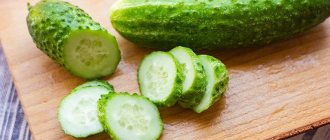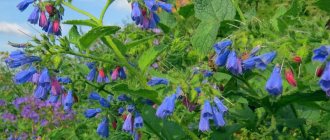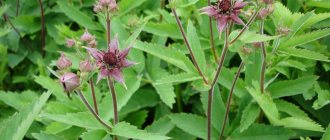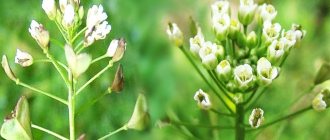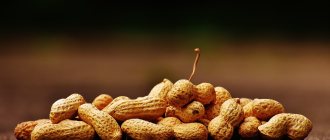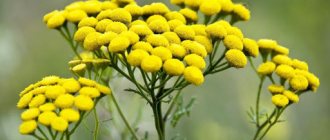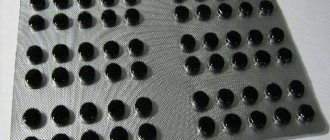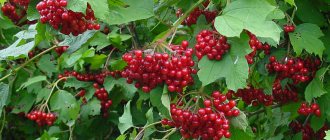In ancient times in Rus' they said “I wish I could live to sleep”. That is, when the moth appeared in early spring, there was no longer any need to be afraid of hunger.
Why did our ancestors to whine Yes, because after a long winter it was practically the first plant that could be collected and eaten.
For food, it is better to collect young leaves and shoots while they are still yellow-green and, as it were, “transparent”. By the way, such leaves can be found even in summer on the honeydew growing in the shade.
Young leaves of snot are added to soups, cabbage soup, okroshka, salads, and borscht instead of cabbage. You can save the squash in pickled form. It is fermented, salted, dried and used as a seasoning in winter.
Botanical description
The rhizome is horizontal, creeping. The stem is straight , hollow grooved, somewhat branched at the top, up to 1 m high. The lower leaves are twice trifoliate, the leaflets are pointed, oblong-ovate up to 8 cm long, sharp-serrate along the edge; The upper leaves are trifoliate on short petioles, small. The leaves are almost bare above, pubescent below. The venation is pinnate. The inflorescence is a complex umbel with 20-30 rays, the diameter of the umbels is 10-15 mm in diameter) of 15-20 flowers, without involucres or involucres. The apical umbrella is fertile, the lateral ones are sterile. The flowers are small and white. Five stamens, 1 pistil. The fruit is an oblong, flattened brown two-seeded seed, 3-4 mm long.
Flowering time occurs at the end of June or beginning of July. The flowers are small, white, collected in umbrella-type inflorescences. It has a pleasant aroma similar to the smell of celery, a good honey plant. After flowering, brown fruits flattened on the sides remain.
A special feature of this plant is its long rhizomes. They are very tenacious, spread across the soil, and quickly take root. They can quickly fill the area.
Use as a honey plant
The gooseberry is an excellent honey plant. During the entire flowering period, it collects bees and other insects to collect nectar. The honey productivity of the planting is estimated at 240 kg of honey per hectare, maximum values are achieved in warm and humid weather. The approximate daily weight gain of one hive can be 3-4 kg. During a month of active collection, it reaches 30-40 kg.
Types of dream
- Common borer (Aegopodium podagraria L.)
- Variegata (Aegopodium podagraria Variegata)
- Alpine warbler (Aegopodium alpestre)
| Snitch Common | Mowing Variegated | Snyt Alpine |
| Food product | Ornamental plant | Ornamental plant |
| Medicinal plant |
Other types of snot in Russia. This is the broad-leaved gooseberry , which is found only along the shores of Lake Baikal, and the Kashmir gooseberry - very miniature. This species is also distinguished by thinner roots and stems, and finely reticulated leaves.
The beneficial properties of dreamweed as a medicinal plant and food product are manifested to a greater extent in common dreamweed.
Contraindications
The only contraindication known today is individual intolerance to sleep. There have been no cases of plant overdose or related problems. The plant even exerts its laxative effect gently, without causing unnecessary inconvenience.
There is no reliable data on the advisability of use during pregnancy and breastfeeding. Therefore, it is recommended to approach the use of the plant with caution during these periods. The same applies to the use of the plant by children.
Decorative types of dream
Alpine warbler (Aegopodium alpestre) and variegated warbler (Aegopodium podagraria Variegatum) are not as aggressive as weeds, unlike common warbler . But abundant reproduction allows them to quickly spread throughout the entire area. So you need to be careful that they do not turn into malicious weeds and limit their spread. These types of grass are used as decorative ground cover perennials on lawns and parks. Read more about this in the article: “Ground cover perennials [planted instead of lawn grass]”
Decorative properties of dream:
- completely covers the soil without gaps or bald spots;
- does not fade for a long time, retains its decorative effect from May to October;
- does not require transplantation;
- unpretentious, does not require special care;
- Grows well in both shade and sunny areas.
Name confusion
In the Russian language there are several variants of the name of this plant - snyt, snet, sned, snetka, snit. In his explanatory dictionary, Dahl explains that it is the last name that is considered correct and attributes the error to the result of translation by foreign botanists, in this case, the Germans, who named botanical cultures “by hearsay,” introducing their distorted names into all textbooks. However, it is this spelling and pronunciation that has taken root in Russia.
It is interesting that the Latin name of the species is consonant with the disease "gout", which, among others, is treated with the help of this medicinal plant - "podagraria", and the genus itself - "Aegopodium", which means "crow's foot print" due to the shape of the leaves.
Nutritional value of dream
The beneficial properties of dream as a food product are determined by its rich chemical composition. Sap is a source of vitamins and microelements. It contains a lot of vitamin C, which is exactly what you need after a long winter.
The mineral composition of honeydew leaves is represented by a number of micro- and macroelements. A significant potassium content was found - 3.8–8.3%. The beneficial properties of honeydew are explained by the presence of almost all microelements vital for humans: Ca, Fe, Si, P, Mg, Al, Mo, V, Cu, Ga, B, Ti, Zn .
Young shoots, leaves and leaf petioles are used as food, from which cabbage soup, soups, borscht are cooked, side dishes are prepared, seasonings for meat and fish dishes, and salads are made. The leaves are fermented for the winter, like cabbage, and the petioles are pickled. You can use it to add vegetables to give them a unique flavor.
The plant can be added to any snacks, first and second courses. Such a “seasoning” will not only “not spoil” them, but will enrich them with vitamins, microelements and other useful biologically active substances, besides giving them charm and some flavor piquancy.
Tomato is a low-calorie plant. But at the same time, the composition contains large quantities of extractives, crude protein and fiber, which are so beneficial for the digestive system. It is also rich in vegetable protein, which makes it a valuable product in dietary and vegetarian menus.
Chemical composition
Our ancestors knew for a long time that borer has high nutritional properties. According to modern folk healers, its chemical composition is similar to the formula of human blood. They claim that this plant has a rich biological composition that is very beneficial for humans.
Among them:
- Polyacetylenes (natural pesticides with pronounced antifungal properties). Due to this, the leaves of the tree can be used to prevent food spoilage. These same substances are actively used in experimental medicine as an antitumor component.
- Amino acids that take part in redox processes.
- Essential oils with pronounced antiparasitic properties.
- Flavonoids, which have a beneficial effect on the urinary system, demonstrate anti-inflammatory and antiallergic properties.
- Carotene (vitamin A), which has an antioxidant effect, promotes skin regeneration and slows down the aging process.
- Coumarins (natural antibiotics with anti-inflammatory and analgesic properties). Take part in activating hair growth.
- Polypeptides that take an active part in carbohydrate metabolism.
- Saponins. Actively stimulate secretory function and intestinal motility.
- Steroids affecting cholesterol metabolism.
- Organic acids. They demonstrate antioxidant, choleretic, diuretic, anti-inflammatory and antitoxic properties, stimulating the immune system.
- Choline, which takes part in lipid metabolism and has a hepatoprotective effect.
- Phytoncides, which are excellent immune stimulants, have antibacterial, antiviral and antifungal properties.
- Complex of vitamins and microelements. This herb (especially young) is a source of many beneficial substances, thereby stimulating the immune system and strengthening the body.
Such a rich chemical composition of honeydew makes it indispensable in the practice of traditional medicine.
Medicinal properties of dream
Why is it useful ? Dreamweed contains choline, which plays an important role in metabolism, and at the same time improves mood and brain function. It has a powerful anti-inflammatory effect and helps remove toxins.
The beneficial properties of the dream are used for medicinal purposes. Both fresh and dried leaves are suitable for this. A decoction, infusion, or powder is prepared from the herb, which is consumed orally or used for compresses or rubbing.
By the way: many wild plants contain more useful substances than their cultivated counterparts. The fact is that these bioactive substances are useful not only for us. In plants they play a protective role and help them compete in natural conditions. And in the garden beds, competition is weakened: we help domesticated plants with watering, fertilizers, and weeding. Therefore, they are pampered, large, fleshy, juicy, pleasant to the taste, but they contain less antioxidants and other substances essential for health.
Therapeutic properties of dream
- relieves inflammation;
- strengthens the immune system;
- eliminates pain syndrome;
- calms the nervous system;
- accelerates the excretion of urine and bile;
- heals wounds;
- has a detrimental effect on fungal infections;
- removes toxins;
- protects against the influence of carcinogens.
These are not all the beneficial properties of dreaming. It helps perfectly with migraines, insomnia, joint and muscle pain, and depression. Dreamweed extract is even included in many expensive medications.
External use of dreamweed
Dreamweed has long been used in folk medicine. As a rule, fresh or dried leaves of the plant, as well as rhizomes, are used. You can buy it at the pharmacy or prepare it yourself.
It is used externally in the form of poultices, infusions or ointments.
In folk medicine, recipes have been preserved for the use of honeydew for various ailments:
- It was used as a herbal poultice to treat gout (deposition of salts inside the joint due to metabolic disorders).
- Also, poultices made from honeydew are used in the treatment of rheumatism, arthritis and arthrosis, which relieves pain and significantly improves well-being.
- Compresses can be made from both fresh leaves and dried raw materials.
- It is widely used in the treatment of skin diseases, diathesis and erysipelas, as well as in the treatment of inflammation of skeletal muscles - myositis.
Internal use of drugs from dream
The main beneficial properties of dreamweed are that it has an immunostimulating, restorative and wound-healing effect. Improves blood formation. It is also a diuretic and improves digestion.
Weed grass contraindications
Like any medicinal plant, honeydew has contraindications, which must be taken into account in order to avoid side effects.
- Pregnant and breastfeeding women should use this herb with caution. Because an allergic reaction is possible.
- The plant is not recommended to be taken for a long time. It is better to use honeydew in courses, like any other medicinal plant.
- If you have chronic diseases, you should consult your doctor about treatment.
- Not all medicines and herbs can be used with sedative preparations.
- Individual intolerance is possible.
Infusions of dream, preparation and use
For diseases of the kidneys and bladder, 2 tbsp. Pour 250 ml of boiling water over spoons of chopped fresh herb and leave for 1 hour in a thermos. Strain and drink 50 ml 4 times a day before meals.
For rheumatic diseases, 2 tbsp. tablespoons of the crushed upper parts of the plant, pour 1 glass of hot water, boil in a closed glass or enamel container in a water bath for 15 minutes, cool for 45 minutes, strain through 2-3 layers of gauze, squeeze and add boiled water to the original volume. Use throughout the day in equal portions for rheumatism, gout, kidney and bladder diseases, as well as for fungal skin diseases.
Fresh crushed leaves or juice from them are used for pain-relieving compresses for gout and rheumatism.
For diathesis
Pour 3 teaspoons of the herb with 2 cups of boiled water, leave for 2 hours, strain. Take 1/3 cup 4 times a day before meals for diathesis and eczema.
For diseases of the digestive system
Fill a liter jar one-third full with crushed pine roots, fill with 40% alcohol to the top, close with a lid and leave for 10–15 days in a dark, warm place. Drink 20–25 drops 3 times a day 20 minutes before meals. The course of treatment is 1 month.
Snitch-grass. What kind of plant is this?
WITH
The common whine is called Aegopodium podagraria in Latin. "Aegopodium" literally translates to "goat's foot." This name was assigned to it by Carl Linnaeus due to the external similarity of the outlines of the leaves with the imprint of a goat's hoof. The second word “podagraria” comes from the Greek “ποδάγρα”, which translates as “foot trap”. This is due to the fact that the use of sedum for pain in the legs has long been known.
As for the Russian name “snyt”, there is an opinion that this is a modified word “sned”, which means “food”. Indeed, there are also names for snit, such as “snit”, “snitka”, “sned-grass”. The nutritional properties of dream have been known in Rus' for a very long time. The saying “If only I could live to sleep!” has survived to this day. The thing is that the young leaves and shoots of this grass were used for food after a long winter, when all supplies of grain and other products were already running out. They fermented it and salted it, cooked cabbage soup with it and dried it for future use.
Speaking about the nutritional properties of dream, one cannot help but recall the fasting feat of St. Seraphim of Sarov. Living as a hermit in the depths of the forest on a hill near the Sarovka River, five miles from the monastery, Father Seraphim did not even take bread from the brethren for several years. Everyone wondered what he ate. He discovered this secret shortly before his death in 1832. It turned out that the priest collected the mushrooms, put them in peas, adding a little water, and put them in the oven. According to him, the food came out delicious. And for the winter he dried this grass. This is what he fed on for a thousand days.
We have also reached the historical fact that during the Great Patriotic War, catering workers went to prepare food for Moscow canteens.
Nowadays, you can also find information about the nutritional properties of dream in the scientific literature. In the Great Medical Encyclopedia, this plant is mentioned in the article “Food Greens” along with the usual dill and parsley.
When and how to collect
The beneficial properties of honeydew are better manifested if the raw materials are properly prepared and processed.
For drying, the plant is harvested in May, and for salads and soups, the plant can be harvested until the buds appear. But you only need to pick young leaves and tops, they are the most tender and juicy. This rule is universal for collecting all wild plants. Use only young leaves and shoots for food and harvesting.
The medicinal raw material is the aerial part, less often the roots. The grass is harvested during flowering. Dry in the open air and then in a dryer at a temperature of 25-30 ° C. The roots of the plant are dug up after the flowering period of the plant, washed in cold water and dried in the shade or under a canopy. The dried aerial parts are stored in a closed glass container, and the roots in a wooden container. The shelf life of raw materials is 1 year.
Preparation and storage
The squash is harvested from the end of April to the end of August. Particular attention should be paid to young plants (which are considered the most useful and are collected in the spring). Those who usually pay attention to the lunar calendar can be recommended to do the preparation in the phase of the young Moon.
They say that it is during this period that all the beneficial juices are concentrated in the shoots.
The process of preparing dried honey includes the following steps:
- Collection (collection means mowing dry plants or digging them up along with the roots).
- Preparing the sap (it should be carefully sorted out, if necessary, damaged shoots or parts of the root should be removed, washed under running water).
- Drying plants. The shoots are laid out or hung in a dry, well-ventilated place (avoiding direct sunlight) and dried until completely dry, turning over periodically.
- The roots are cut into smaller pieces before drying. An alternative to natural drying is drying in an electric dryer (at low temperatures).
- Storage. Dried mushrooms are stored and used throughout the year in fabric or paper bags in ventilated areas. It can also be stored in the form of ground powder.
Culinary recipes for dishes with soup
It is not only a medicinal plant, but also a tasty plant, which is not inferior in nutritional value to many other products. At the same time, you can use it without fear of gaining excess weight.
The leaves and thin stems can be used as a seasoning. You can add fresh chopped herbs to any dish. It goes perfectly with any dishes with meat and fish, soups and casseroles and salads.
Snot is well suited for filling pies, vegetable caviar, and even cutlets are made from snot. Let us give as an example some recipes for dishes with soup.
Rejuvenation salad
Finely chop 10 young leaves, 2 peeled cucumbers, half an avocado and season with 1 dessert spoon of unrefined vegetable oil.
Vitamin salad
The leaves are washed, chopped, mixed with finely chopped green onions, dill and parsley, salted, seasoned with sour cream and sprinkled with chopped boiled egg. Ingredients: 100 g of honey leaves, 20 g of green onions, dill and parsley, 1 tbsp. spoon of sour cream, 1 boiled egg, salt.
Snitch stewed with potatoes
Young leaves and shoots of the gooseberry are finely chopped, salted, and stewed until half cooked. Then mix with stewed potatoes and onions, add sour cream, simmer for another 10-15 minutes and season with tomato sauce. Ingredients: 100 g of leaves and shoots of honey, 100 g of potatoes, 1 onion, 1 tbsp. spoon of sour cream, 2 teaspoons of tomato sauce, salt.
Pasta with sourdough – Spring
Ingredients:
- pasta – 400 g,
- greens: kale and turnips, nettles, spinach, gooseberry and other herbs – 200 g,
- bacon – 100 g,
- onion – 1 pc.,
- cheese (preferably hard or goat cheese, with a pronounced taste) – 100 g.
Preparation : Boil the pasta. 2 minutes before readiness, add greens to them. Drain in a colander. Fry the bacon cut into strips. Fry finely chopped onion until golden brown. Place the pasta in the pan with the onions, add the fried bacon and cheese, stir and heat until the cheese melts.
Dream cutlets
- 500 g dreamy
- 100 g white bread
- 200 g boiled potatoes
- 2 raw eggs
- 2 tbsp. butter
- 3 tbsp. breadcrumbs
- Salt, pepper, other herbs - to taste
- Rinse the young leaves of the sorrel in hot water and pass through a meat grinder.
- Also mince potatoes and white bread. Mix all.
- Add eggs and finely chopped herbs. Mix. Salt and pepper.
- Make cutlets and roll in breadcrumbs.
- Fry in butter, serve with sour cream.
Soup puree of nettles, pine and other greens
Ingredients:
- young nettle – 300 g,
- wild garlic greens (bear onion, victory) – 200 g,
- young snyti – 200 g, or stalked celery – 2 petioles
- carrots – 1 pc.,
- potatoes – 1 pc.,
- onions – 1 pc. or leek - 1 pc.
- vegetable or meat broth - 0.5 l,
- vegetable oil – 1 tbsp. spoon, butter – 25 g, milk – 3 tbsp. spoons.
Preparation: fry chopped onions, leeks, celery, carrots and potatoes in a frying pan in a mixture of oil. Add salt. Add a little water, cover with a lid and simmer for 15–20 minutes. Pour in the broth and simmer over low heat for another 10 minutes. Add nettles and other herbs, cook for 2 minutes, then remove the soup from the heat and rub through a sieve or puree using a blender. Pour in the milk and heat until boiling again. Pour into plates, add a little butter or vegetable oil to each and sprinkle with finely chopped herbs.
Omelette with sour cream and onions
Ingredients: young leaves of honey - 100 g, green onions (ramson, batun, chives, slime) - 200 g, greens with a neutral taste (nettle, radish leaves, turnips, kale) - 100 g (optional), eggs - 4 pcs., cheese (Adyghe, Suluguni or other Caucasian) - 50 g, adjika - 1 teaspoon (if you like it spicy), vegetable or butter for frying.
Preparation: wash the greens, cut into strips and simmer for 5-7 minutes in oil until soft. Grate the cheese on a coarse grater. Lightly beat the eggs, add cheese and, if desired, adjika. If the cheese is lightly salted, add some salt. Pour the egg mixture over the greens, cover the pan with a lid and cook the omelet as usual.
Pickled leaves of common squash
The young leaves of the plant are placed tightly in sterile jars, poured with marinade, and a few grains of pepper are added. Used as a side dish for meat and fish dishes.
Indications for use
Due to its rich chemical composition and complex of medicinal properties, representatives of alternative medicine recommend pine to help externally and internally with the following diseases and conditions:
- tumors;
- atherosclerosis;
- avitaminosis, scurvy;
- renal pathologies;
- gastrointestinal diseases;
- gallbladder pathologies;
- gout, arthritis, arthrosis, rheumatism, myositis;
- decreased hemoglobin;
- problems with the nervous system;
- neuroses, insomnia;
- diseases of the cardiovascular system;
- blood pressure;
- iron deficiency anemia;
- decreased appetite;
- pain of any nature (primarily joint pain);
- for wound healing;
- fungal diseases;
- diathesis;
- swelling.
For women's health
Sleeping is a great help for women who want to maintain health and beauty. So, it is recommended to use it to maintain and preserve youthful facial skin. For this purpose, masks are used to which gruel or juice of young leaves is added.
It is believed that such masks help improve skin elasticity and reduce wrinkles. And to achieve an even greater effect, it is recommended to add a little olive oil to the mask.
For even additional tone and rejuvenating effect, the juice from young leaves of the dream can be mixed with clean water (in equal parts) and frozen in the form of cubes. It is recommended to wipe your face with these cubes every morning.
And to cleanse your skin in the evening, you can use a paste of leaves and cucumber.
You can add the juice of fresh leaves to hand cream (to moisturize the skin) and shampoo (to make your hair silky)
For health after 50 years
After 50 years, certain diseases often appear, chronic illnesses make themselves felt, so our health requires a more careful approach.
One of the main problems is general slagging. To avoid it, representatives of alternative medicine recommend regular cleanings.
For this purpose, borer (its young shoots) can be used. To prepare the cleanser, the shoots are washed well, doused with boiling water and ground in a meat grinder. The juice is squeezed out of the resulting pulp, diluted with boiled water and taken for 10 days according to the following scheme:
- Day 1: mix 1.5 tablespoons of juice with the same amount of water and drink a tablespoon 3 times 20 minutes before meals;
- Day 2: mix 3 tablespoons of juice with the same amount of water and drink 2 tablespoons 3 times 20 minutes before meals;
- Day 3: drink undiluted juice, 1 tablespoon 3 times 20 minutes before meals;
- Day 4: drink undiluted juice 2 tablespoons 3 times 20 minutes before meals;
- Days 5-10: undiluted juice is drunk 50 grams 3 times 20 minutes before meals.
It is important to monitor your body's reactions throughout the cleansing period. And, if allergic reactions occur, stop taking the cleanser immediately.
From the first day of taking the juice, you need to monitor your well-being and if allergic reactions occur, the procedure should be stopped.
How to get rid of weeds on your property
To remove a tree from a site, it is not necessary to pull it out by the roots; moreover, it is almost impossible to do so. Even the smallest remnants of the rhizome will quickly produce new growth. It cannot survive without leaves, so by regularly cutting them off along with the petioles, after a while you can get rid of it.
How to get rid of weed if it has become a malicious weed is the topic of a special article, which will soon be posted on our website. Follow the news!
Online store Fazenda plus
Growing in an apothecary garden
Those who want to have fresh smelt greens “at hand” can grow it in their own garden, and this will not be difficult. The main concern in this case is limiting the area where it grows by installing a physical barrier to the roots growing in breadth. The depth of the root system is 20-30 cm, so the fence should go into the ground at least 40 cm. Pieces of old slate, metal sheets or a ready-made special border tape of sufficient width are suitable for this.
Planting is carried out either by seeds or by a bush dug from nature. Its rhizome will quickly produce layering, but the process will speed up if you dig it up along with the finished buds.
Important! The weed easily spreads not only by rhizomes, but also by seeds, so timely cutting of inflorescences is mandatory!
Therapeutic recipes of traditional medicine using dream
For pathologies such as rheumatism and gout, diseases of the urinary and renal systems, inflammatory processes in the joints, infusions based on thyme are used. To prepare such an infusion, you need to pour a couple of tablespoons of honey into a glass of boiling water, then boil for about a quarter of an hour and strain. Then a glass of boiled water at room temperature is added to the strained infusion. The infusion is consumed one glass during the day.
For rheumatism, a very good result is obtained from gruel obtained from crushed leaves. This paste is applied to the affected areas and replaced with a fresh portion as needed. For neuralgia, myositis and chronic fatigue, it is necessary to take special relaxing baths that contain a decoction based on the root of the dream. Externally, lotions based on fresh leaves are used when necessary to quickly and effectively get rid of acne and festering wounds, boils and other skin diseases.
Planting and caring for the tree
- Planting: sowing seeds - in spring or before winter.
- Flowering: the plant is grown as a medicinal or decorative foliage.
- Lighting: for decorative deciduous species – shade or partial shade, for medicinal species – bright light.
- Soil: any.
- Watering: regular but moderate, during periods of prolonged drought - more frequent and abundant.
- Feeding: when grown in poor soil at the beginning of summer, the plant is fed with a weak solution of organic or mineral fertilizer.
- Pruning: during the summer to maintain decorativeness.
- Reproduction: seed.
- Diseases: anthracnose, powdery mildew.
- Pests: aphids and spider mites.
- Properties: the plant has healing properties.
Read more about growing honeydew below.
Growing dreamweed in the garden
How to sow seeds
The plant is sown like any other herb. Sowing is carried out in spring or before winter. The sown area must be limited so that the weed does not spread throughout the garden. To do this, iron sheets or slate are dug along the perimeter of the bed so that they go into the ground at least 30 cm.
- Irises in the garden
Creeping wheatgrass - harm and benefit, planting and care
If you want to grow decorative honeydew on your property, you can purchase its seedlings in specialized stores or garden pavilions. It is better to first plant them in plastic or iron containers with drainage holes, and then dig these containers into the soil in the flower garden.
In the photo: Flowering dream
The moth prefers shady places and grows well under trees, but in a sunny place the variegated variety of the plant will not be so attractive.
Caring for the dream
Water the trees regularly. During drought, the plant requires more frequent watering, but water consumption should be moderate. Decorative varieties and plant species require periodic sanitary pruning: diseased, dry and damaged shoots should be removed. Some gardeners renew their greenery by completely mowing down the plant.
Hogweed - how to fight, treat burns, beneficial properties
To preserve the decorative appearance of the plant, it is necessary to promptly remove the peduncles with inflorescences, otherwise the sapling will gradually degenerate into a wild-growing form: only the common sapling can grow from the seeds spilled on the ground.
When growing squash in poor soil, it is advisable to add fertilizers to the soil - organic or mineral - at the beginning of summer. However, do not overdo it: it can do without feeding.
In the photo: Dream leaves
The plant is winter-hardy and can withstand frosts down to -39 ˚C without requiring shelter.
- Strelitzia at home, types
Pests and diseases
Sometimes the tree is attacked by aphids or spider mites. This usually happens during a period of prolonged drought. If you notice that the leaves of a plant are curling, take a closer look at them and you will likely find pests parasitizing the plant. They destroy mites and aphids with solutions of Actellik, Matcha or Aktara.
Dwarf can suffer from fungal infections that cause anthracnose or powdery mildew. These diseases must be combated with the help of drugs Skor, Horus, Maxim, Radomil Gold or other fungicides of similar action.
Reviews
To my taste, squash boiled in soup adds a fishy flavor to the dish. Not everyone likes this taste, but I liked it. But first blanched and then fried with nettles, it tastes similar to mushrooms. If you combine this vitamin-rich fry with boiled potatoes, you won’t be able to tear anyone away from this food by the ears.
Angela, 31 years old, Vyazma
There is nothing worse than whining in the garden, except that wheatgrass can compare with it. I spent several years, real years (from April to September) fighting these herbs. Until she turned over layer by layer all the areas with weeds, until she took all the roots out of the ground with her own hands, until she drove these herbs out of the center of the garden and under the fence. It doesn’t bother me to snoop there, but I will continue to fight the wheatgrass.
Svetlana, 28 years old, Lipetsk
Natalia
Author
Ask a Question
Many careful and caring owners manage to live without weeds in their gardens. But sometimes you still need to think about whether it is really necessary to get rid of all the weeds. What if at some point they become our saviors? Health to you and your loved ones!
